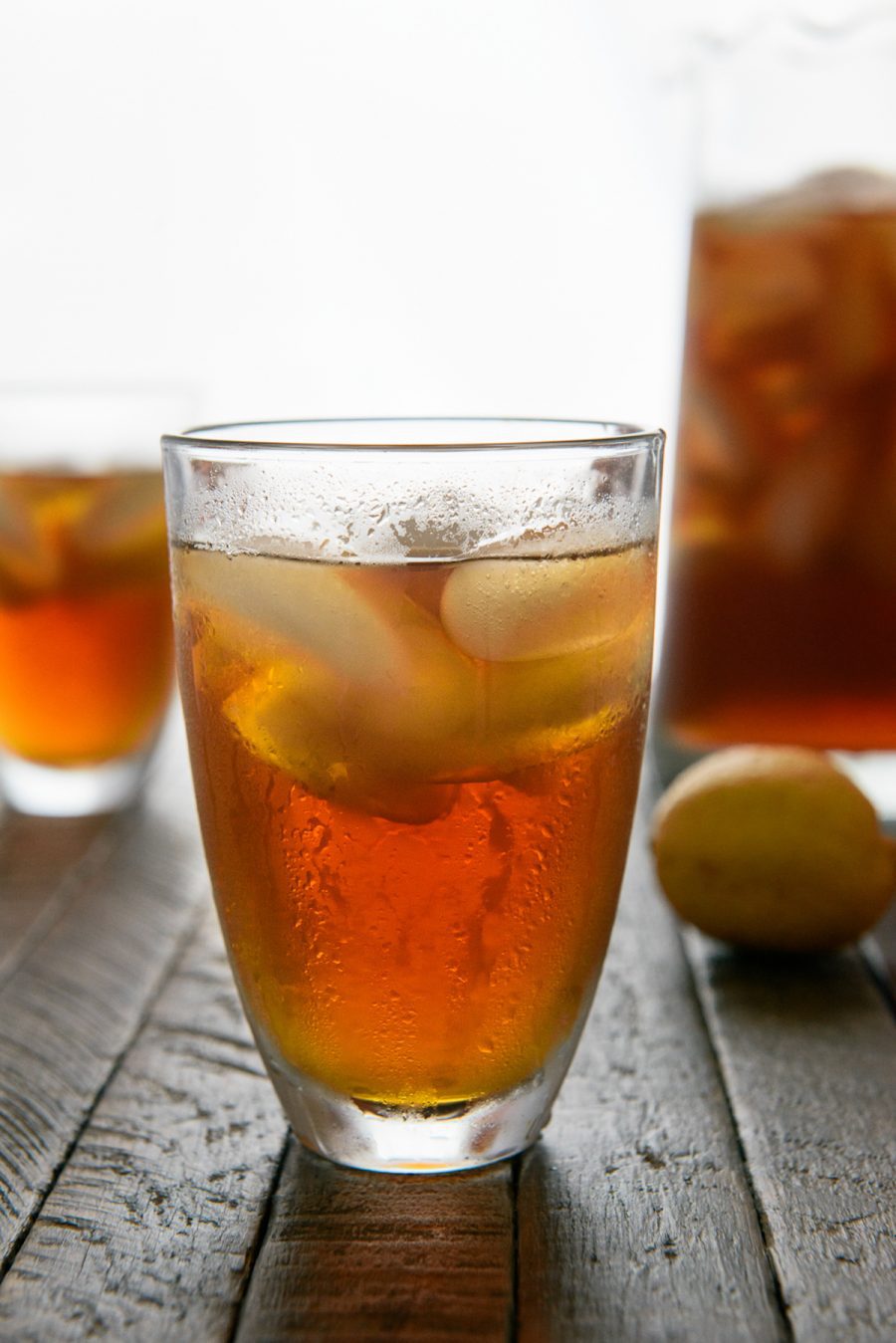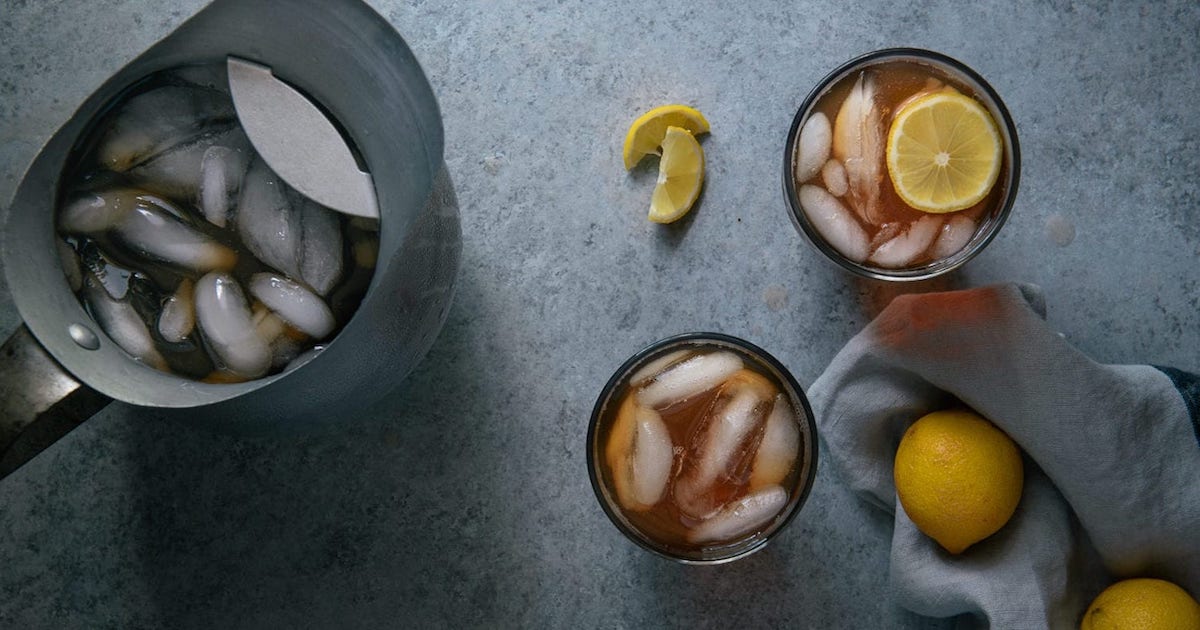Pour Some Sugar on Tea
First, a definition: Sweet tea is freshly brewed black tea that is generously sweetened with sugar while hot, deeply chilled, and served over ice.
Change any of those variables and you have a beverage—perhaps a nice beverage, but that beverage is not sweet tea. Some people never drink sweet tea. (You can lead a horse to water…) Some people indulge once in a blue moon, as a treat or trip down memory lane. Some people drink sweet tea all day long, every day. No matter the frequency, if you ever crave the incomparable quenching relief and comfort found only in a frosty glass of sweet tea, then you are in luck. You might never bake a pan of stellar biscuits or cure a ham to tuck in them. You’ll probably never distill your own barrel of bourbon. But you can make a perfect pitcher of sweet tea. Indeed, the sugary refresh is an achievable Southern culinary masterpiece.

No two historians, whether endowed chair or armchair, can agree on how sweet tea came to be, but most concede to a few facts and conclusions. Some of the earliest attempts to grow tea in North America occurred in the southeast. Camellia sinensis seeds (yes, aromatic tea is a cousin to the fragrant camellias in our gardens), were planted in Savannah’s Trust Gardens in 1744, but they did not germinate. Subsequent attempts to grow tea failed or were abandoned over the next forty or so years. The most successful effort happened in 1795, when French botanist Andre Michaux began importing tea, camellias, gardenias, and azaleas for wealthy Charleston planters and established the first domestic tea plantation. Despite other plantations and tea companies giving it a go, all tea in the Charleston area had disappeared by the early 1900s. A Lipton research facility on Wadmalaw Island tried again in 1960, using some of the original tea plants grown at one point at a plantation near Summerville. This facility became better known as the Charleston Tea Plantation, now owned by Bigelow. It is the only tea plantation in North America, and one can take trolley tours.
An entrenched yarn about iced tea originating at the 1904 World’s Fair is charming but untrue. From antique cookbooks and household records, we know that affluent households served chilled tea starting in the mid-1800s. Early references to chilled tea came in recipes for alcoholic green tea punches, such as the notably potent Chatham Artillery punch. From history books and firsthand recollections, we know that green tea was most common for iced tea until World War II interrupted imports from our regular sources. We turned to tea imports from locations controlled by our allies, such as India and Ceylon (now Sri Lanka), where black tea was more common than green. Like tea and sugar, ice was expensive. Entrepreneurs cut huge chunks of ice out of frozen ponds in New England, insulated it as best they could with sawdust, and sent it south on trains where it was stored in ice houses and sold to those who could afford it.

When rural electrification spread through the South and refrigeration rode in on its coattails, access to ice became more common and affordable, and so did the availability of iced tea. When and where did someone first sweeten iced tea? Theories abound and communities make bold claims out of hometown pride and tourism campaigns. Like most culinary eurekas, the magic moment is lost to the ages, but it probably wasn’t in the South. Scholars of sweet tea found documentation of people drinking sweet tea up north as far back as the 1860s. The oldest known sweet tea recipe appeared in 1879 in Housekeeping in Old Virginia by Marion Cabell Tyree, but that proves little. Recipes in old community cookbooks didn’t launch common practices; they documented them. Thanks to a confluence of factors, sweet tea became a food tradition that seemed to cross all social, ethnic, and economic boundaries in the South. For better and for worse, the idea of Southern sweet tea has become so ubiquitous that it is nearly a trope. We hear anecdotes and cautionary tales of tea served so thick and syrupy sweet that a spoon could stand up in it. But, really, even if sweet tea is a staple in meat-and-three restaurants, barbecue joints, and some households and cup holders, not all Southerners serve or even like sweet tea. But some did, and some do, and some will—and that’s why it’s good to know how to make it right.

Classic Sweet Tea
Peach Iced Tea Sorbet
Slushy, Boozy, Sparkling Citrus Tea
Arnold Palmer Tea Bread
share
trending content
-
FINAL Vote for Your Favorite 2025 Southern Culinary Town
-
Get To Know Roanoke, Virginia
-
Shrimp and Grits: A History
by Erin Byers Murray -
New Myrtle Beach Restaurants Making Waves
-
FINAL VOTING for Your Favorite Southern Culinary Town
More From At the Table
-
The Harvest: Apple Recipe Round-Up
-
Well Preserved: A Chef’s Home Guide to Preservation
-
10 Jewish-Inspired Recipes for Rosh Hashanah
-
6 Brunch-Themed Tailgate Recipes
-
Cooking for Comfort









